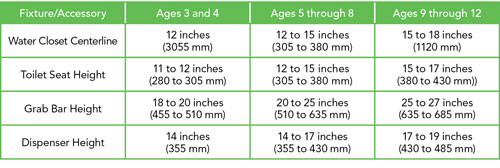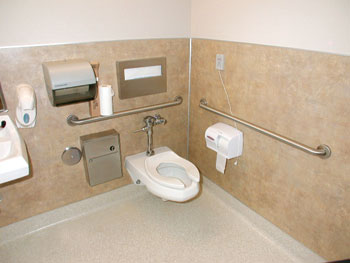A Practical Guide to 2010 ADA-Compliant Restroom Design
Another difference between the 1991 standard and the 2010 ADA Standard (section 308.1) is that the 2010 standard outlines acceptable reach ranges for children according to age. These reach ranges are intended to be used when elements like coat hooks, lockers, toilet compartments, lavatories, and other fixtures and accessories will be primarily used by children.


The 2010 ADA Standard provides an advisory specifically focused on specifying toilet compartments for children's use (section 604.9). The table on the next page provides additional guidance for specifying toilet compartments for children according to the age group served and reflects the differences in size, stature and reach ranges of children ages 3 through 12. It is suggested that the chosen specifications correspond to the primary user group.
Increased Clear Floor Space Around the Water ClosetClear floor space (CLFS) is defined as the minimum unobstructed floor or ground space required to accommodate a single, stationary wheelchair and occupant. The 2010 ADA Standard is increasing the amount of clear floor space that is required around a water closet. According to section 604.3.1, clearance around the water closet shall be 60 inches minimum measured perpendicular from the side wall, 56 inches minimum measured perpendicular from the rear wall for a wall-hung water closet, and 59 inches minimum measured from the rear wall for a floor-mounted water closet. This increased clear floor space is allowed to overlap the water closet, grab bars, toilet paper dispensers, sanitary napkin disposal units, coat hooks, shelves, accessible routes and turning space. No other fixtures or obstructions shall be located within the required water closet clearance.
New Centerline for the Water ClosetUnder the 1991 standards, the centerline for the water closet, which refers to the space from the side wall to the center of the toilet, was required to be an absolute 18 inches. Under the 2010 ADA Standard, the centerline of the water closet must fall within an established range of 16 inches minimum to 18 inches maximum from the side wall or partition. The centerline of the water closet in an ambulatory-accessible compartment can be between 17 and 19 inches from the side wall or partition.
 |
|
Photo courtesy of The ASI Group In this non-compliant example, the seat cover dispenser does not have the requisite clear floor space for wheelchair use. |
Arguably one of the most anticipated changes in the 2010 ADA Standard is the inclusion of construction tolerances. “Speaking practically about restroom design, it is quite common that there may be a slight variance in the measurement identified in the drawing and the actual tile and porcelain implementation. It is usually close, but rarely exact,” explains Michael Chambers, FAIA, FCSI, CCS, principal at MCA Specifications in Ukiah, California. “In the old standard, if the toilet was not exactly 18 inches at the centerline, it was non-compliant. The 2010 ADA Standard recognizes the reality of construction tolerances and has replaced many of the absolute values with acceptable ranges for placement.”
Additional Considerations for ADA-Compliant Restrooms
Many of the 2010 ADA Standard's requirements that apply to restroom design remained the same from one standard to the other, but they are no less critical to creating compliant restrooms. Here we will review seven key considerations that must be incorporated into any ADA-compliant design.









